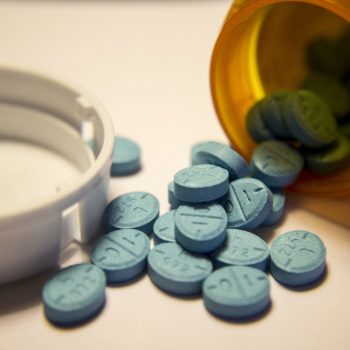Percocet Addiction
Percocet

What is Percocet?
First, oxycodone activates opioid receptors in the brain and spinal cord. That way, it alters how the brain perceives pain.
Second, acetaminophen elevates the brain’s pain threshold, the upper point beyond which it would start to sense pain. The higher the pain threshold, the lower the pain would be felt. Moreover, acetaminophen blocks the production of prostaglandins in the brain. Prostaglandins are chemicals involved in swelling and pain sensation.
Percocet is available in the form of oral tablets. The tablets contain 325 milligrams (mg) acetaminophen and varying strengths of oxycodone. The amount of oxycodone in each tablet ranges from 2.5 mg to ten mg.
Street Names of Percocet
•Ercs
•Greenies
•Kickers
•M-30s
•Percs
•Rims
•Tires
•Wheels
•512s
Percocet belongs to a class of drugs known as opioid combinations. These products mix an opioid with a non-opioid pain drug, such as acetaminophen, ibuprofen, and aspirin.
These products are used for the short-term management of moderate-to-severe pain.
Examples of such products include:
•Anexsia (hydrocodone + acetaminophen)
•Apadaz (benzhydrocodone + acetaminophen)
•Norco (hydrocodone + acetaminophen)
•Percodan (oxycodone + aspirin)
•Reprexain (hydrocodone + ibuprofen)
•Tylenol #3 and Tylenol #4 (codeine + acetaminophen)
Percocet contains a Schedule II controlled substance – oxycodone. Acetaminophen is not a controlled substance.
Schedule II substances have high abuse potential. Misusing or abusing them can cause severe psychological and physical dependence.
Examples of drugs in Schedule II are:
•Hydromorphone (Dilaudid)
•Methadone (Dolophine)
•Meperidine (Demerol)
•Fentanyl (Sublimaze, Duragesic)
Is Percocet Safe?
A drug product reaches the market only after it has passed several safety and efficacy tests. These tests are carried out in the laboratory, animals, and humans. Even after the product has been available on the market, the US FDA continues monitoring its safety. It is known as post-marketing surveillance.
Every drug can cause unwanted effects along with the desired effects. Before prescribing a drug, your doctor checks if the benefits outweigh the potential risks.
Percocet has been on the market for over four decades. The product was often considered the gold standard of pain management in the early 2000s. Notably, both oxycodone and acetaminophen have a proven track record of safety and efficacy. Based on the available evidence, we can say that Percocet is safe.
Nonetheless, Percocet contains drugs that might cause addiction and liver damage. Besides, post-marketing reports reveal that Percocet can cause potentially life-threatening allergic reactions (anaphylaxis). Interestingly, any drug–or even peanuts or wheat– can cause similar reactions.
Can You Take Percocet During Pregnancy?
Human data on Percocet safety during pregnancy is not available. It may be used if the benefits outweigh the potential risks. Oxycodone can cause physical dependence in infants. The lowest possible dose should be taken to prevent these side effects. Acetaminophen is generally considered safe for use in pregnant women.
Percocet is used to relieve moderate-to-severe pain after an injury or surgery. Doctors prescribe it for the pain that does not improve with other non-opioid painkillers.
Proper Use of Percocet
•Percocet should only be used as recommended.
•The drug should not be taken more frequently, in larger doses, and for a longer duration than recommended.
•The Medication Guide that comes with the product should be read thoroughly, and the doctor or pharmacist should be consulted if questions arise.
•Percocet should only be used by the person who is prescribed the medication.
•Percocet (oxycodone + acetaminophen) is used to treat moderate-to-severe pain due to an injury, tooth extraction, or surgery. Long-term use is not generally recommended because of the risk of abuse and liver damage from acetaminophen.
How is Percocet Abused?
Percocet or any other opioid may be abused to get high. Drug abuse refers to the inappropriate use of medication. Abusing Percocet, even for a few times, can cause addiction and death.
Most notably, Percocet abuse increases the risk of developing an addiction to heroin. The likelihood to abuse Percocet increases when there is:
•A personal or family history of substance abuse. Study shows people with past drug use are more likely to inject crushed Percocet tablets.
•A co-occurring psychiatric problem, such as depression or anxiety
•A history of trauma and abuse
In one survey, researchers asked Massachusetts adolescents about their drug use behavior. The participants revealed easy access and low cost as the main reasons behind using combination products, such as Percocet.6 Most experts agree that easy access is the biggest but often overlooked risk factor for addiction.
Access to Percocet is sometimes illegally obtained by:
•Visiting more than one doctor to get multiple prescriptions (Doctor shopping)
•Using someone else’s prescription
•Purchasing from illicit online pharmacies, a friend, family member or dealer
•Stealing the drug from residences or pharmacies
•Receiving from illegal pain clinic called “pill mills”
The abuse of Percocet may occur by:
•Swallowing the tablet
•Chewing
•Crushing the pills and snorting (the most frequent method of abuse)
•Rarely, smoking crushed tablet or injecting solution made from powered tablet
Mixing Percocet with Controlled Narcotic Substances and depressants like alcohol, opioids, and benzos can cause excessive sedation and slowed breathing. Both of these can cause coma or death.
Signs of Percocet Abuse
The signs of Percocet abuse may not be obvious if a person has been abusing the drug for a few days or weeks. However, over time, changes in behavior, social interactions, and wellbeing may become prevalent.
Below are some of the signs and symptoms of abuse.
•Problems with focus, memory, or judgment
•Slurred speech
•Weight changes
•Increased irritability
•Unusual mood swings
•Restlessness
•Changes in sleep schedule
•Loss of interest in normally enjoyable activities
•Avoiding people, including the family members or friends
•Money problems
•Poor performance at school or office
Percocet Effects
What are the Short-term Effects of Percocet?
The effects of the drug will be felt within 30 to 45 minutes after taking a tablet. The two most desirable short-term effects of Percocet are a reduced sensation of pain and an enhanced feeling of well being.
In addition to the desirable effects, it also causes several short-term side effects. They include:
•Constipation
•Nausea
•Vomiting
•Digestive problems
•Sleepiness
•Dizziness
•Headache
•Dry mouth
•Increased sweating
Long-term use of Percocet can cause:
•Brief periods of stopped breathing during sleep
•Irregular breathing patterns
•Increased sensitivity to pain
•Abnormally low blood oxygen levels
•High blood levels of carbon dioxide (can cause •seizures, panic attacks, or coma)
•Increased risk of falls, fractures
•Depression
•Infertility
•Sexual dysfunction
•Decreased testosterone levels in the blood
•Brittle bones, especially in women
•Irregular menstrual periods
•Unusual discharge from nipples in women
•Weak immune systems
Effects of acetaminophen
•Kidney disorders
•Heart disease
•Bleeding in the stomach or intestines
In some people, Percocet can cause potentially fatal allergic reactions or other severe symptoms. Presence of any of the following symptoms should be discussed with a physician immediately:
•Hives and skin rashes
•Swelling of the face, lips, tongue, or throat
•Extreme fatigue
•Pain in the upper region of the stomach
•Clay-colored stools
•Mental confusion
•Goosebumps
•Lack of coordination
•Seizures
•Fainting
•Severe breathing problems
•Shallow or noisy breathing
•Hallucinations
•Dark urine
•Yellow skin or eyes
•Shivering
•Uncontrollable muscle contractions
•Elevated body temperature
•Fast heartbeats
Dependence occurs when a patient cannot function without using a drug. Percocet can cause severe physical and psychological dependence.
Tolerance occurs when one no longer feels the effects of a drug with the initial dose. Stated another way, now, there is a need for more of the drug to feel the same way as with a lower dose.
Addiction is a long-term brain disorder. It causes the continued use of a drug despite the known harms.
Can You Overdose On Percocet?
Overdosing on Percocet is like killing oneself with two different weapons simultaneously. Both oxycodone and acetaminophen can cause severe health consequences and death.
Oxycodone can cause slowed or stopped breathing, which can be deadly. High doses of acetaminophen can damage liver cells and cause liver failure.
Acetaminophen is the number one cause of liver failure in the U.S., ahead of viral hepatitis. Moreover, it is the leading cause of liver transplantation. Each year, acetaminophen overdose causes 56,000 emergency department visits and 500 deaths. Most notably, about half of the overdose cases are unintentional.
Two antidotes for oxycodone overdose are available. They are naloxone and nalmefene. N-acetylcysteine (NAC) is used to prevent liver damage from acetaminophen toxicity. Supportive treatments include oxygen therapy and drugs to raise blood pressure.
Too Much Oxycodone
•Slowed or stopped breathing
•Excessive sleepiness (sometimes, the person does not wake up and may slip into a coma)
•Loss of muscle tone
•Pinpoint pupils
•Cold sweaty skin
•A heart rate below 60 beats per minute
•Low blood pressure
Unusual snoring
Too Much Acetaminophen
Appearing after 48 to 72 hours after overdosing on Percocet.
•Problems with blood clotting
•Nausea and vomiting
•Usual sweating
•A feeling of uneasiness
Death may occur without immediate emergency medical care. 911 should be called immediately, as well as the local poison control center at (1-800-222-1222).
Quitting Percocet
If a doctor thinks there is a longer need for pain relief, they will ask the patient to stop taking Percocet. Moreover, one may want to reduce the dose because they have started feeling better. Opioid medications should not be stopped without a physician’s guidance. Abrupt discontinuation can cause many undesirable effects called withdrawal symptoms. Withdrawal from Percocet can be extremely uncomfortable, but rarely life-threatening.
A gradual decrease in the dose under medical supervision is called tapering. Tapering helps reduce the severity of withdrawal. Depending on the usual dose and intensity of pain, tapering may be done in two ways. They are:
Slow Tapering
It involves reducing the dose by ten percent to twenty percent every seven to 21 days with regular follow-ups. Slow tapering focuses on lowering the doses rather than increasing the interval between two doses. Once one has adapted to the lowest possible dose, they may decrease the frequency of use.
Rapid Tapering
It involves stopping use completely or reducing the doses rapidly over a few days. Fast tapering can cause severe withdrawal. Thus, it is usually carried out in a supervised center.
Withdrawal
Withdrawal may not occur if one is on Percocet for 14 days or less. That being said, withdrawal is unique to every person, and there is no one-size-fits-all approach for discontinuation. A physician’s assistance is needed for all
Withdrawal Symptoms
•Restlessness
•Anxiety
•Increased sensitivity to pain
•Trouble falling or staying asleep
•Nausea
•Vomiting
•Diarrhea
•Elevated body temperature
•Sweating
•Drowsiness
•Shaking
•Fast heartbeats
•Low or high blood pressure
•Mental confusion
•Hallucinations
•Seizures
Treatment for Percocet Addiction
The first step in addiction treatment is detoxification (detox). A carefully designed detox program is essential to removing the drug from the body without the risk of severe withdrawal.
Medications may be needed during detox to relieve withdrawal symptoms and prevent relapse. It is known as medication-assisted detox. Because Percocet addiction can be severe, detox under medical supervision is necessary.
The actual journey to sobriety starts once the system has been successfully cleaned.
Comprehensive addiction treatment involves:
Medications
Methadone and buprenorphine are two commonly used drugs for opioid addiction. These drugs help control cravings and relieve withdrawal symptoms. They are available in inpatient and outpatient treatment facilities.
A severe addiction may require a stay in an inpatient facility for at least a month to several months, with continuing treatment at an outpatient facility once stabilized.
Psychotherapy
Psychotherapy (talk therapy) is an integral part of addiction treatment. It involves:
•Recognizing the drug use behavior
•Identifying triggers
•Building strategies to curb drug use
Cognitive-behavioral therapy (CBT) is a type of psychotherapy. It has incredible benefits in addiction treatment. CBT helps identify and correct problematic thought patterns behind drug use behavior.
Aftercare Programs
These are long-term programs that help a person live a drug-free, meaningful life. In essence, aftercare is more than just preventing relapse. They include long-term monitoring, recovery education, and follow-ups. The duration of these programs can range from one to several years.
- National Institute on Drug Abuse. America’s Addiction to Opioids: Heroin and Prescription Drug Abuse.
- Centers for Disease Control and Prevention. U.S. Opioid Prescribing Rate Maps.
- NCBI Bookshelf. Pain Management and the Opioid Epidemic: Balancing Societal and Individual Benefits and Risks of Prescription Opioid Use.
- Securities and Exchange Commission. Endo Pharmaceuticals Holdings Inc.
- Journal of Medical Toxicology. My Story: How one Percocet Prescription Triggered my Addiction.
- The American Journal of Drug and Alcohol Abuse. A brief survey to characterize oxycodone abuse patterns in adolescents enrolled in two substance abuse recovery high schools.
- The Primary Care Companion for CNS Disorders. A Review of Potential Adverse Effects of Long-Term Opioid Therapy: A Practitioner’s Guide.
- NHS. Is long-term paracetamol use not as safe as we thought?
- British Journal of Clinical Pharmacology. Long‐term adverse effects of paracetamol – a review.
- NCBI Bookshelf. Acetaminophen Toxicity.

We Work With Most Major Insurance Providers
The Safe Harbor Treatment Center’s Admissions Team works to ensure that we can help as many people struggling with substance abuse. Verify your benefits now and we’ll get back to you right away.
Receive the highest level of care available at Safe Harbor. We are here to answer your call or fill out our confidential contact form to get started.

